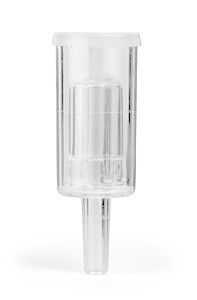 This is a simple no-brainer recipe that yields a slightly cloudy, drinkable wine-cooler-like beverage on the cheap in about two weeks or less. Because the wine is made in the sterile container the juice comes in, it’s much easier to keep contamination out of the process. There is no cooking or heating of any ingredients
This is a simple no-brainer recipe that yields a slightly cloudy, drinkable wine-cooler-like beverage on the cheap in about two weeks or less. Because the wine is made in the sterile container the juice comes in, it’s much easier to keep contamination out of the process. There is no cooking or heating of any ingredients
Ingredients and supplies:
1 bottle (64-128 oz) of high-sugar-content juice such as cranberry juice. Be sure to buy a kind without preservatives to avoid killing the yeast.
1/4 package of wine making yeast. I used Red Star Cotes de Blanc, but baking yeast found at the local supermarket will work.
1 sterilized airlock with rubber stopper that will fit the mouth of the juice bottle. Other airlocks will work, but for this recipe the simple airlock is super easy.
Another easy way to create an airlock is to make the tiniest pinprick in a regular balloon and stretch it over the mouth of the bottle. The balloon will expand after a day or so, and deflate a bit when the fermentation is done.
What do airlocks and walruses have in common? They both like a tight seal.
Lastly you need a quantity of sugar to sweeten the wine when it’s done.
Assemble all the tools and ingredients. Grab your large bottle of cheap Cranberry Juice. I found a bottle where the sugar content was a whopping 39g per 8 oz serving, which is why I used it. You can add sugar to increase the content, but be careful here. Too much sugar will retard their growth. Also “pushing” the yeast too far can lead to the nasty hangover chemicals.
The yeast will either ferment out all the sugar or die in their own waste. The waste is primarily ethanol (drinkable alcohol). But they also produce other nasty things, like fusel oils (other weird alcohols) and congeners (weird flavors). Many types of yeasts die at an alcohol content of 10 – 15%. The closer the yeast get to the dying in their own waste, the more weird flavors and vomity chemicals they make. So it’s sometimes best to limit the sugars to no more than 40 – 50 grams per 8 ounces (~240 ml).
Without contaminating the juice add about a 1/4 packet of wine making yeast, available online or from any wine making/home brew shop. Replace the cap and give it a gentle shake to distribute the yeast.
Place your sterilized airlock on top of the bottle. (Dipping the airlock and rubber stopper in a bowl of cold water with a cap full of bleach will suffice to sterilize your equipment. Be sure to rinse all the bleach solution off.) Place the bottle in a dark, room-temperature place for 7-14 days. The fermentation process will be visible after a day or so as evidenced by vigorous bubbling. When the bubbles stop after what seems like forever, move on to the next step.
 Siphon or pour off the top part of the wine into a separate sterile container, making sure to not disturb the dead yeast which has accumulated at the bottom. Do not be greedy, the stuff at the bottom looks and tastes bad, throw it away.Taste it and cringe. If you like the ultra-sour taste of cranberies, wow, but most of us will want to add a bit of sugar or juice to taste. The sugar may reactivate the process if all the yeast isn’t dead. This can lead to an exploding bottle, or a carbonated surprise if consumed right away, so store with caution.
Siphon or pour off the top part of the wine into a separate sterile container, making sure to not disturb the dead yeast which has accumulated at the bottom. Do not be greedy, the stuff at the bottom looks and tastes bad, throw it away.Taste it and cringe. If you like the ultra-sour taste of cranberies, wow, but most of us will want to add a bit of sugar or juice to taste. The sugar may reactivate the process if all the yeast isn’t dead. This can lead to an exploding bottle, or a carbonated surprise if consumed right away, so store with caution.
Another variation could be to “rack” the wine. After pouring the wine off the yeasty muck on the bottom, the wine can be stored in a glass vessel to increase the taste and clarity. This can take anywhere from a week to a few months, to later be transferred to it’s final bottle. Basically, you’re letting all the tiny particulate matter settle to the bottom, clarifying the wine and improving flavor.
You can bottle the wine in sterilized vessels, or drink it right away. If you bottle it, make sure the fermentation process is complete (no bubbles), otherwise the bottle could explode after a few days on the shelf.
Serve chilled.
Price list (2015)
Juice: $2
Wine yeast packet: $.80
Rubber stopper: $.40
Air Lock: $1.50
Sugar: $.50.
Total for first batch: $5.50


